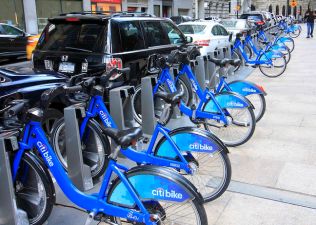The Citi Bike Story No One’s Talking About: Only 3 Injuries in 500,000 Rides

It seems like the local press has run through so many permutations of the Citi Bike story that now it’s time to recycle Citi Bike stories from a year ago.
One month after the system launched, the AP ran a story about the lack of a helmet requirement for Citi Bike riders (because helmet requirements have proven so successful in other cities, don’t you know), and the Observer published more alarmism yesterday about the risks faced by bike-share riders who lack health insurance (because of course it should be up to the bike-share operator to make up for the market failure to provide everyone with affordable health care).
It’s all very reminiscent of the fearmongering bike-share report put out by Comptroller John Liu last year and the news cycle that followed. The Post even ran a squib from the AP story based on the same outlandish prediction from Rutgers University professor John Pucher that figured so prominently in Liu’s report — that bike fatalities would skyrocket after Citi Bike launched.
Well, Citi Bike launched more than a month ago, and there have been no deaths or serious injuries. Unless this first month was a total outlier, Citi Bike won’t result in a significant increase in bike fatalities in NYC, let alone the doubling or tripling predicted by Pucher. As the AP glossed over quickly, only three minor injuries have resulted after more than 500,000 rides. It’s too early to extrapolate what the Citi Bike safety record will be over the course of an entire year, but it’s safe to say the injury rate on Citi Bike so far is much lower than the overall bike injury rate in NYC.
In 2011, the most recent year for which data is available, there were 3,448 reported bike injuries in NYC, or about 9.4 per day, according to crash records compiled by the state DMV [PDF]. (Most of these injuries are classified as minor.) To figure out the rate of injuries per trip, you’d need to know the number of bike trips each day, but data on citywide bike trips is sketchy. However, the most generous estimate of daily biking in NYC that I’ve ever encountered is Charles Komanoff’s figure of 665,500 trips per day [XLS]. I happen to think that overstates the actual number of bike trips, but it’s a good number to determine the lower bound of the injury-per-trip rate. It works out to one injury for every 70,800 bike trips.
Meanwhile, with just three reported injuries and 529,000 rides in the first 31 days of Citi Bike operations, the safety record for New York City bike-share riders is much better: One injury per 176,000 trips. That’s about 2.5 times safer than our very rosy assessment of the injury rate among non-bike-share cyclists.
A few Citi Bike injuries in quick succession could change these early results, but it seems like New York is experiencing the same pattern observed in Boston, Washington, London, and other bike-share cities. Bike-share riders are less likely to be injured in traffic crashes than people riding their own bikes.
Assuming this pattern holds up in New York, it’s a ripe area for study. It suggests, among other things, that the AP’s headline, “No Helmets Required for Bike-Share in Busy NYC,” is even sillier than it seems at first glance. Bike-share users, who in addition to having low injury rates also tend to have lower-than-average rates of helmet usage, are great proof that encasing your skull in case you crash is just one factor among many that affect bicycle safely. There are several other steps riders can take that may be more important. (And, of course, there’s a wide range of proven public policy options to make streets safer that’s beyond the individual cyclist’s control.)
Maybe sturdy three-speeds help people react in time to avoid potential hazards. Riding with an upright posture where you can easily scan the streets around you might be safer than hunching over drop handlebars and craning your neck. It could be that fat tires minimize the risk that crappy pavement will throw you from the saddle.
The number of studies about these factors is dwarfed by the research on the effect of helmets. But the experience with bike-share is telling us that, when it comes to the choices people make while riding, there’s a lot more to safety than putting a styrofoam shell on your head.
